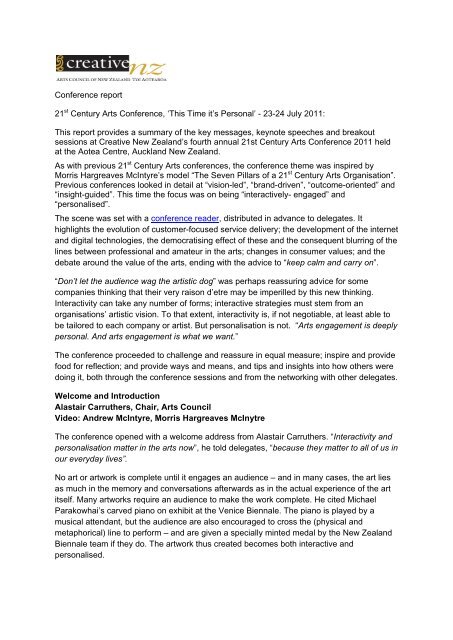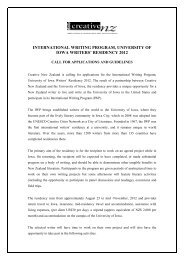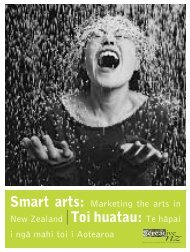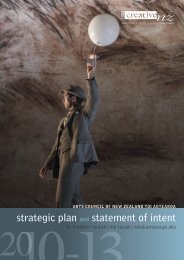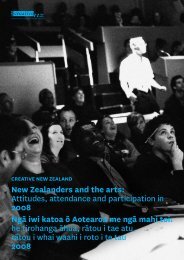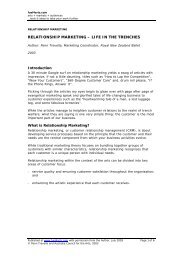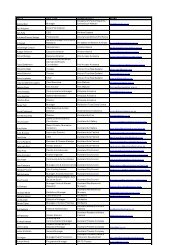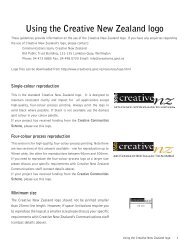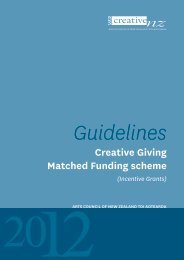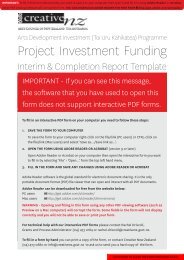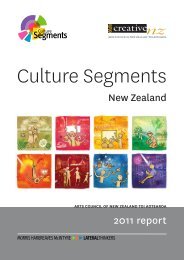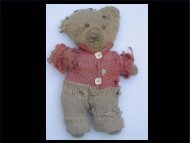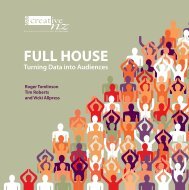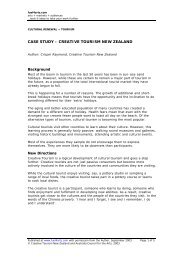Download PDF 626 KB - Creative New Zealand
Download PDF 626 KB - Creative New Zealand
Download PDF 626 KB - Creative New Zealand
You also want an ePaper? Increase the reach of your titles
YUMPU automatically turns print PDFs into web optimized ePapers that Google loves.
Conference report<br />
21 st Century Arts Conference, ‘This Time it’s Personal’ - 23-24 July 2011:<br />
This report provides a summary of the key messages, keynote speeches and breakout<br />
sessions at <strong>Creative</strong> <strong>New</strong> <strong>Zealand</strong>’s fourth annual 21st Century Arts Conference 2011 held<br />
at the Aotea Centre, Auckland <strong>New</strong> <strong>Zealand</strong>.<br />
As with previous 21 st Century Arts conferences, the conference theme was inspired by<br />
Morris Hargreaves McIntyre’s model “The Seven Pillars of a 21 st Century Arts Organisation”.<br />
Previous conferences looked in detail at “vision-led”, “brand-driven”, “outcome-oriented” and<br />
“insight-guided”. This time the focus was on being “interactively- engaged” and<br />
“personalised”.<br />
The scene was set with a conference reader, distributed in advance to delegates. It<br />
highlights the evolution of customer-focused service delivery; the development of the internet<br />
and digital technologies, the democratising effect of these and the consequent blurring of the<br />
lines between professional and amateur in the arts; changes in consumer values; and the<br />
debate around the value of the arts, ending with the advice to “keep calm and carry on”.<br />
“Don’t let the audience wag the artistic dog” was perhaps reassuring advice for some<br />
companies thinking that their very raison d’etre may be imperilled by this new thinking.<br />
Interactivity can take any number of forms; interactive strategies must stem from an<br />
organisations’ artistic vision. To that extent, interactivity is, if not negotiable, at least able to<br />
be tailored to each company or artist. But personalisation is not. “Arts engagement is deeply<br />
personal. And arts engagement is what we want.”<br />
The conference proceeded to challenge and reassure in equal measure; inspire and provide<br />
food for reflection; and provide ways and means, and tips and insights into how others were<br />
doing it, both through the conference sessions and from the networking with other delegates.<br />
Welcome and Introduction<br />
Alastair Carruthers, Chair, Arts Council<br />
Video: Andrew McIntyre, Morris Hargreaves McInytre<br />
The conference opened with a welcome address from Alastair Carruthers. “Interactivity and<br />
personalisation matter in the arts now”, he told delegates, “because they matter to all of us in<br />
our everyday lives”.<br />
No art or artwork is complete until it engages an audience – and in many cases, the art lies<br />
as much in the memory and conversations afterwards as in the actual experience of the art<br />
itself. Many artworks require an audience to make the work complete. He cited Michael<br />
Parakowhai’s carved piano on exhibit at the Venice Biennale. The piano is played by a<br />
musical attendant, but the audience are also encouraged to cross the (physical and<br />
metaphorical) line to perform – and are given a specially minted medal by the <strong>New</strong> <strong>Zealand</strong><br />
Biennale team if they do. The artwork thus created becomes both interactive and<br />
personalised.
“Audiences”, he noted, “demonstrate their engagement through a range of responses – both<br />
positively and negatively”. Participation and engagement are at the heart of what art does.<br />
The challenge to arts practitioners is to break down barriers to engagement in the arts, to<br />
work so that the gap between audience and artist is no longer a mysterious divide, and to<br />
make experiences we create as artists and arts managers so engaging that “these<br />
experiences are as commonplace as going to the supermarket”.<br />
A short video from Andrew McIntyre (Morris Hargreaves McIntyre) discussed the themes<br />
canvassed in the conference reader: the importance of cultural experiences emphasising<br />
interaction as the way people engage with culture changes; the explosion in digital<br />
technology; the challenges of dwindling younger audiences; and the current lively debate<br />
about how we should relate to audiences.<br />
Interaction, personalisation and co-creation are all part of the spectrum of audience<br />
engagement. But growth of and interest in interactivity is not new. Artists and audiences<br />
have interacted for centuries. “Twitter didn’t invent word of mouth” and audiences were<br />
responding vociferously to theatre when Shakespeare was alive.<br />
We’re told there is a “pro-am revolution” and that technology and the internet have<br />
accelerated the move towards co-creation in the arts. “But is it true?” McIntyre questioned.<br />
Will audience of the future stop wanting to consume art and only want to co-create?<br />
“Interactivity is a powerful way to engage people in the arts, but it is not the only way.”<br />
The arts can reach every human being and satisfy myriad human needs (intellectual, social,<br />
emotional/aesthetic, spiritual) in myriad ways. Arts audiences are sophisticated, eclectic and<br />
diverse. Interactivity and co-creation haven’t stopped people from losing themselves in a<br />
favourite painting, or having the hairs on the back of their neck stand up when they hear a<br />
particular piece of music. While personalisation is non-negotiable, interactivity should be<br />
approached in a way that fits your artistic vision. And whatever you do, says McIntyre, you<br />
should be relentlessly audience focused.<br />
Welcome Keynote Address<br />
Stephen Wainwright, Chief Executive <strong>Creative</strong> <strong>New</strong> <strong>Zealand</strong><br />
The 21 st Century Arts Conference, noted Stephen Wainwright, offers the arts community a<br />
chance for reflection.<br />
“We are still a young society”, he noted – “and one where the arts have not had the role they<br />
may have played in longer-established societies”. He used his own up-bringing as an<br />
illustration of how far removed many <strong>New</strong> <strong>Zealand</strong>ers were from creative experiences as<br />
they grew up in the ’50s and ’60s.<br />
Rugby racing and beer dominated our national psyche, and in most families, often headed<br />
by tradespeople, no one attended university. Mothers stayed at home, and formal education<br />
(as little as a generation or two ago) ended with primary school. It’s only a generation or two<br />
back that any boy who didn’t play rugby was labelled a sook or worse, and there is an<br />
“ongoing suspicion in this country of the effete, the intellect and the ‘arty’.”<br />
At the same time, society is underpinned by the <strong>New</strong> <strong>Zealand</strong> ideal of “fairness” and a work<br />
ethic stemming from the Puritan roots of the early settlers. For Pakeha boys at least, recalled
Wainwright, “there was no encouragement to express emotion and feeling”; the physically<br />
remote and isolated male was epitomised in the humble All Black, who having scored the<br />
winning try, jogged back to the centre, eyes downcast, “wondering what the hell the bloody<br />
commotion was all about”.<br />
There wasn’t, as Wainwright put it, “a lot going on encouraging creativity and emotion.”<br />
But powerful forces were unleashed in the ’60s and ’70s: feminism, the expansion of<br />
universities, easy and affordable international air travel. Internal Affairs started supporting<br />
artists to travel overseas. And the counterculture movement from the late ’60s and the<br />
protest movement of the ’70s provided a wake-up call to artists. For not quite the first time,<br />
artists began expressing themselves in the <strong>New</strong> <strong>Zealand</strong> idiom, and outside formal<br />
education there were growing opportunities to participate in the arts.<br />
Fast forward to 2011. “It is hard not to draw the conclusion that the most remarkable<br />
progress had occurred… In a short time, as a culture, we’ve raced up Maslow’s hierarchy.”<br />
There is a proliferation of opportunities for artists to make art and for people to engage with<br />
it; of arts and cultural festivals in cities and communities all over the country; and<br />
opportunities to see and experience art.<br />
For art to flourish a society needs the creation of art works, places to make it happen and<br />
audiences to engage with it. There has been investment from private enterprise and the<br />
state; the building of Te Papa, the establishmentof the Maori Language Commission;<br />
support for local content on television and radio, to name just a few initiatives. In short, we<br />
have left cultural cringe in our wake and developed a degree of comfort in our own identity –<br />
and in expressing it. Peter Jackson has shown it’s cool to be creative. And even on the<br />
rugby field, emotion is okay.<br />
We “should be a little bit pleased and iconically humble about what we have achieved.”<br />
Our challenge now in the arts is to ask with whom and for whom are we seeking to be<br />
interactively engaged and personalised, and why, Wainwright said in conclusion. Can we<br />
have impact only on those who engage with us or should we try to interact with those who<br />
have not yet experienced what we do? In a country that is undergoing turbo-charged<br />
demographic change, are we in the arts ready?<br />
Wainwright suggested that the arts community is not often enough reaching into segments of<br />
the community not touched by the arts. While 72% of <strong>New</strong> <strong>Zealand</strong>ers engage with the<br />
statement that “the arts are for people like me”, 27% don’t. And only 40% of tickets<br />
purchased are bought by males. The challenge for the arts is to ensure that excellence does<br />
not translate into exclusivity or elitism (which goes right against the <strong>New</strong> <strong>Zealand</strong> egalitarian<br />
grain). We must demonstrate that we’ve successfully opened doors to a wider public. We<br />
should share, like John Maynard Keyes, in a goal of making the theatre, the concert hall and<br />
the art gallery a living element in everyone’s lives.<br />
The relative youth of most of our arts companies acts as a reminder of how young we are as<br />
a nation. We owe it to our ancestors to acknowledge what they handed down to us, but we<br />
must also, in the words of Michael King, “persist in building our own culture”.
DAY ONE: INTERACTIVITY<br />
Keynote Address<br />
Andy McKim, Artistic Director, Theatre Passe Muraille<br />
Engaging Our Community: Building the bridge while walking on it<br />
Theatre Passe Muraille (TPM) is the oldest theatre in Canada for the development of new<br />
work. Andy McKim took over as artistic director in 2007 on the anniversary of its fourth<br />
decade. He has revitalised the theatre in part because he focused on the question of how to<br />
engage with the artists and the public in his community. In his address he spoke about<br />
“history, values and acts of engagement”.<br />
TPM was founded in an environment, fuelled by the centenary of the foundation of Canada,<br />
that was asking what it meant to be Canadian. Toronto was a traditional, homogeneous<br />
Anglo-Saxon city with little evidence of the many decades on immigration that had been<br />
taking place. “We now live in an exciting intercultural mash-up” – the new face of Canada,<br />
said McKim. TPM values this diverse audience – and with 550 new Canadian plays to its<br />
credit, reflects many of the community’s stories in its repertoire.<br />
It was not always such a rosy picture. Four years ago, TPM was almost bankrupt and had<br />
lost its way. TPM’s founder, director and playwright Jim Garrard, had stressed the<br />
importance of not only creating new works that reflected Canadian experience, but of<br />
developing new models through which to engage with audiences. Garrard’s successor Paul<br />
Thompson developed The Farm Show, now a staple of Canadian theatre. It epitomised the<br />
ethos of TPM in which actors go into communities and meet an audience who don’t share<br />
the same values. By interacting, each develops different viewpoints.<br />
By 2007, TPM needed to reconnect with these founding principles. TPM is devoted to<br />
encouraging meaningful engagement between its communities: artists, staff, audiences,<br />
neighbourhoods and supporters. It holds complementary values: supporting and presenting<br />
new artists and companies; collaborative and multidisciplinary work; and presenting<br />
alternative and marginalised voices.<br />
McKim recognised that TPM had become abstracted from it audience. “We were in essence<br />
broadcasting to the audience through a megaphone. Either you liked what we did – or not.<br />
But we didn’t seek out their opinion. We were the artistic decision-makers – why would we<br />
need to directly involve the community in our activities?”<br />
“There is no doubt we have undervalued our community’s ability to be creative, articulate<br />
and passionate about the arts,” he said. “But people are engaging in the arts all the time,<br />
without our guidance. If we give them more room to participate, we may see a rise in our<br />
institutions’ relevance and attendance.”<br />
TPM has now restructured so that its value-based, non-hierarchical organisational model<br />
reflects the artistic process, and its vision and values. McKim has removed the silos “that<br />
create job segregation” and re-designated staff roles so they are all part of a management<br />
team moving TPM forward collaboratively. All are called associate producers. All accept<br />
responsibility for the marketing, promotion and ongoing development of the theatre. In
eturn, TPM makes a commitment to their growth and development. For example, each has<br />
the opportunity to produce one show each year, mentored by a manager.<br />
Other changes to build bridges between the theatre and its communities included creating a<br />
welcoming environment for the audience. Front of house staff are recognised as a critical<br />
audience interface, and pre-theatre chats and entertainment were introduced. Next season<br />
McKim, the general manager or one of the associate producers will attend each<br />
performance, speak with the audience informally beforehand, and then again after the show.<br />
“We want to make sure people feel valued and feel comfortable.”<br />
TPM’s four-page vision and values document is given to all staff, and they are encouraged to<br />
check any decisions they make against this. Not only did this have the effect of embedding<br />
the values, it also resulted in staff members making more decisions on their own.<br />
The diversity of shows presented represent TPM’s community and its values: independent<br />
artists and companies; open and welcoming to any audience; emerging and marginal voices;<br />
ethno-specific and intercultural work. In the 2010-2011 season the programme includes<br />
puppets, emerging artists, plays based in the stories of real people, collaborative creations<br />
and a multidisciplinary approach to theatre making. “They are shows that are open, available<br />
and entertaining to any audience.” The diversity also makes audiences not often seen in<br />
theatres to feel welcome.<br />
McKim offered specific examples of how he is building the community engagement bridge<br />
one step at a time:<br />
• He has stopped broadcasting messages. Rather, he values trying to “engage one<br />
person at a time”. For example, TPM realised it needed someone from the<br />
neighbourhood on the Board – as local people didn’t know what went on inside the<br />
building. McKim left a card with an invitation to call him in a letterbox in the<br />
neighbourhood, and was rewarded with a (hesitant) phone call (after the caller had<br />
checked out just who he was and whether the card was for real). That caller is now a<br />
Board member and staunch advocate for TPM.<br />
• He also operates the TPM “Pitch Blitz” – an open opportunity for artists to get five<br />
minutes one-on-one with him, to audition, to pitch, simply to talk or to introduce<br />
themselves. This has been a success on both sides. “We are more accessible to the<br />
arts community and we have discovered a variety of interesting people and<br />
companies who we are now engaged with us on a multitude of levels.”<br />
• Engaging new audiences. For example, TPM decided to collaborate rather than<br />
compete with other nearby theatres. They set up banners along the street that let<br />
people know about all three theatres in the vicinity. And they organised the<br />
“Bathurst Street Theatre Marathon”. Audiences attend a play at each of the theatres<br />
in a matinee-to-evening series of productions, including supper at a local restaurant.<br />
McKim attends the marathon and engages with new audiences attracted by the<br />
event.<br />
• Programme diversity to engage new communities. TPM is determined to be an arts<br />
centre for the community and not just a subscription theatre. Diverse artists (improv<br />
groups, emerging artists, a clown festival, dancers, musicians) are offered a home at<br />
the theatre and time to perform there. Each new artist brings a new audience.<br />
McKim believes that if the community sees the diversity of the artists performing
there, they will feel that TPM is a diverse and inclusive organisation where they are<br />
welcome.<br />
Other bridge building initiatives have included:<br />
• A Naturists’ evening at the theatre – a performance where clothing was optional!<br />
A huge hit – and a great publicity opportunity.<br />
• Audience dramaturgy. The Buzz Festival is a new work and audience<br />
development festival where the audience become participants in the play<br />
development process. The audience is provided with background to each new<br />
work and there is an interchange of views between the audience and artists both<br />
during and after the play development sessions. With the artists always<br />
ultimately in control of the creative product, but the audience engaged in a new<br />
and intimate way, this has drawn positive reactions from both audience and<br />
artists.<br />
• Theatre Beyond Walls (a play on the company’s French name) is a pioneering<br />
programme where stories from the community will be the starting point for the<br />
development of new works. Artists will leave the building for a season to involve<br />
local audiences in 12 locations around Toronto in the development and creation<br />
of art works. Projects will include ”writers-out-of-residence” on the Toronto<br />
Queen Street car; verbatim texts and interviews with taxi drivers as the starting<br />
point for a theatre piece; and a play based on the homeless and mentally ill<br />
people who will also take part in creating the work.<br />
• The performance of Yichud (Seclusion), set in the orthodox Jewish community.<br />
In all these projects there is a strong desire to develop community collaborations with nonartistic<br />
organisations and communities. “We get to meet a community we don’t know,” said<br />
McKim, “and they might get to meet a culture they don’t know.”<br />
TPM is, through these and other initiatives (including social media to reach younger<br />
audiences) moving to an approach based on dialogue and interactivity. It aims to encourage<br />
people to create their own communities that reflect their own culture, and develop stories<br />
that are meaningful to them.<br />
“We hope this will be emblematic of a new way for a cultural institution and the city of<br />
Toronto and the citizens to engage with one another to create something that is inspiring to<br />
all of us and created by all of us.”<br />
There is a big job ahead for us as cultural leaders, he adds. How can we be the purveyors of<br />
the public’s ability to engage with art? TPM will continue to forge the path it has established,<br />
buoyed by the response to the engagement activities undertaken to date, and those on<br />
which they are about to embark.
Plenary Session and workshop<br />
Remix the Orchestra: Barbara Glaser, CEO Auckland Philharmonia Orchestra and DJ<br />
Anonymouz<br />
Barbara Glaser, chief executive of the Auckland Philharmonia Orchestra and Matt Faiumu<br />
Salapu (Anonymouz) presented a unique orchestral/hip-hop crossover initiative that the APO<br />
has developed with the Otara community over the past four years.<br />
Remix is based on the belief that music has the power to change people’s lives, and fits with<br />
the orchestra’s vision and mission – to enrich the lives of Aucklanders through music.<br />
When the APO started Remix in 2008, it was very much a “toe in the water. We started not<br />
knowing where it would end, and it involved an element of risk…. We are still working<br />
through the larger vision of how it fits with our core practice.”<br />
Remix is not consciously an audience development programme. Its value, said Glaser, is in<br />
what is delivered to the community, not necessarily about whether the participants ever<br />
come to a Mahler symphony.<br />
Remix was not a case of the orchestra “plonking itself in Otara”. The Otara Music and Arts<br />
Centre (OMAC) is a strong partner in the programme. Noma Sio from the orchestra, was<br />
instrumental in developing the programme alongside Salapu, who has classical training<br />
(piano) but has always been engaged with hip hop and other music genres.<br />
Most participants have never been up close to an orchestra and are blown away by the<br />
music, “– as are our musicians at the sophistication of hip hop music,” said Glaser.<br />
The programme has two aspects: for gifted and talented musicians from the Otara<br />
community; and for at-risk youth. They and a small group of orchestral musicians work<br />
intensively over two separate one-week programmes to create new works that fuse hip hop<br />
and orchestral genres and use elements of both. The week culminates on a performance for<br />
family and friends, and participants take away a CD of the music created.<br />
Is it successful? “Absolutely it is. We focus on how it stretches and develops individual<br />
participants, and the way it engages people with the orchestra by the end of the week. It has<br />
an impact on individuals and on the community we are working in. It has opened both sides<br />
to new experiences,” said Glaser.<br />
And while it has sometimes been a challenge for both, it generates “a massive amount” of<br />
creativity in a very short time, and has resulted in much wider learning than simply music.<br />
Social rewards from the programme have come through the personal development of<br />
participants.<br />
Matt Salapu spoke “from the Otara side”. Remix, he said, is a fusion of two different worlds –<br />
while classical music is centuries old, hip hop is only 30 years old, and the musicians take<br />
completely different approaches to the music. Hip hop is based on sampling – borrowing bits<br />
you like from any music, while classical music tends to frown on such improvisation. Remix<br />
fuses the spontaneity of hip hop with the discipline of classical. The programme is a form of<br />
“time travel” – taking concepts and ideas from 300 years ago and making them relevant<br />
today.
Participants step far outside their comfort zones – and to demonstrate this and the musical<br />
outcomes of the Remix the Orchestra programme, four classical and four hip hop musicians<br />
stepped onto the stage and presented the composition of one participant who had turned his<br />
life around through the encounter with Remix. It was an inspiring and moving presentation<br />
and performance, rewarded with a standing ovation.<br />
BREAKOUT SESSIONS DAY ONE<br />
We’re all in this together: Emma Bugden, The Dowse<br />
This session revolved around discussion about curatorial and institutional responsibility to<br />
audiences. Emma Bugden focused the discussion around two projects she had previously<br />
curated. She also talked about her recent relocation to Lower Hutt, the move from Artspace<br />
to The Dowse and the different communities and audiences that the different institutions<br />
deliver to.<br />
She noted that over the last 20 years, curators’/institutions’ work has somewhat moved away<br />
from exhibitions driven by artefact/object towards situation/community-based curatorial<br />
drives – often artist/community lead. This was interesting to consider in terms of whom the<br />
‘power’ sits with and the responsibility of the curator to deliver to different community groups.<br />
The first project discussed was an exhibition called Oblique, 1999, for which 30 <strong>New</strong><br />
<strong>Zealand</strong> and international artists travelled to Otira to make new work in a<br />
residency/exhibition situation.<br />
Interesting conflicts arose from this project, including the conflict between collaborating and<br />
commissioning and the chasm between curatorial intention and the reality of how your<br />
audience responds to a concept. In this project, the local community reacted quite differently<br />
to how the curator had anticipated (the local community used the project and media to<br />
promote their own concerns). This blurred the boundaries between the role of the artist,<br />
participant and viewer and led the curator to consider the importance of local knowledge and<br />
networks in engaging your audience.<br />
The second example was BLOCK which took place at Artspace. This was a collaborative<br />
exhibition between German artist Daniel Knorr and a group of prisoners from the <strong>New</strong><br />
<strong>Zealand</strong> corrections system.<br />
The exhibition consisted of three parts – a film made in collaboration with the prisoners, a<br />
series of paintings and drawings, and an installation. The project came about from the<br />
curator’s interest in the systems that surround us in our community and also looked at the<br />
role of art in prisons. The project was difficult emotionally and in terms of the logistics of<br />
collaboration. Bugden noted that having a mediator/facilitator and support from the<br />
corrections system in this project was integral to how the project was delivered and how it<br />
was framed to the audience.<br />
She noted that there was some concern from both the participants and the audience that the<br />
exhibition would be a one-off event. While the expectation was that it was the<br />
curator/institution’s responsibility to maintain an ongoing relationship with the prisoners, this<br />
prompted discussion within the workshop as to whether it was responsible for a curator to
commit to a one-off community project without a long term strategy, a curator’s moral<br />
commitment to communities, and how to continue to deliver to that community and work in<br />
an ongoing way with your audience.<br />
Using Audiences to Create <strong>New</strong> Work: James Ashcroft, Taki Rua Productions and<br />
Andy McKim, Theatre Passe Muraille<br />
Andy McKim presented a workshop that articulated Community Cultural Development<br />
principles and offered some valuable reminders/pointers and examples for arts organisations<br />
wanting to engage with their communities:<br />
• Find as many ways as possible to involve people in the dramaturgy<br />
The work is the product of our engagement. Example: Playwright in residence sat on<br />
tramcar and talked with the diverse passengers/people to elicit stories and responses.<br />
This was a process of engagement with people which was also a process of work<br />
development<br />
• Creation of new work is grounded in a particular community. Plays describe a city<br />
and its social groups.<br />
• Often playwrights and theatre companies have been telling stories of interest to each<br />
other but not to the public.<br />
• Theatre Passe Muraille is trying to tell stories, sometimes, of interest to those who<br />
don’t come or aren’t coming to the theatre. Telling these stories is a way of being a<br />
leader.<br />
• One project started with a small number of stories told to the playwright by recent<br />
migrants. They involved others, and the audience for these very specific stories was<br />
nearly 2000 people. This sort of process is an avenue to transformative work.<br />
• The process of engagement doesn’t mean authorship is handed over to the<br />
community.<br />
• McKim’s biggest challenge is “my peers and their concerns about doing things that<br />
don’t have models”.<br />
• Theatres/playwrights are leaders. We need to take up this responsibility and find<br />
stories that people want to hear and give them a transformative experience.<br />
• We’re not trying to force people into participation but to listen.<br />
• McKim forcefully reinforced the point about programming the art not the venue.<br />
• Old fashioned marketing is the same as broadcasting and is onedirectional. TPM’s<br />
process of engagement is curating and networking with audiences.<br />
If audiences don’t want to be passive consumers, how radically do we need to rethink<br />
our organisations? Panel Discussion, chaired by Andrew McIntyre
Panellists: Aidan Lang, NBR <strong>New</strong> <strong>Zealand</strong> Opera – Carla Theunnisen, Q Theatre – James<br />
McCarthy, Te Tuhi Arts Centre – John Smythe, Theatreview<br />
With a question as long as that, this discussion was bound to throw up conflicting ideas. The<br />
following is a summary of panellists’ and audience thoughts:<br />
• What level of passivity are we talking about? Some art forms don’t readily lend<br />
themselves to moving beyond the proscenium arch in performance – but does that<br />
mean audiences are passive? They have taken a very active step in purchasing<br />
tickets. Some forms of theatre are very [overtly] interactive – e.g. pantomime,<br />
comedy.<br />
• Even in theatres where actors/musicians are on stage, the audience have always<br />
contributed – theatres are not darkened temples. Being present with actors and<br />
musicians creating a performance is not a passive experience – it has an<br />
extraordinary effect on people, far removed from hearing the same work on a CD.<br />
• Theatres will not be as relevant in the future as they are now. Technology is causing<br />
massive shifts in the way people partake in art. Making art is now more interactive<br />
and one-to-one. Companies will have a digital producer as well as a live one.<br />
• Often the people having the most fun in a theatre are the performers. <strong>New</strong> styles of<br />
performance can be emotive and powerful and put the audience in the performer’s<br />
seat. It’s difficult to be bored if you are interactively engaged.<br />
• It’s only in the 20 th century that we’ve put the “fourth wall” in performance venues and<br />
audiences have become passive absorbers of the performing arts.<br />
• “I don’t believe that sitting in a dark auditorium is passive if you are empathising,<br />
having thoughts, engaging with concepts of moral dilemma.” (John Smythe)<br />
• There is still room for the playwright-initiated work creatively developed by other<br />
people – that’s where the deep thinking happens. Tricky novelties will not engage<br />
audiences.<br />
• A youth audience needs stimulus in another way. This is a valid audience and should<br />
be provided for.<br />
• The shared theatrical experience generates a magical bond between audience and<br />
performers. And the tone of the performance can be completely changed according<br />
to the reaction of the audience.<br />
• Audience engagement doesn’t have to mean interactivity or co-creation. Immersion<br />
in an art experience can be still (as in a gallery) but not passive because your head is<br />
filled with ideas and meanings – one is taken to another time and place.<br />
• Social media is one aspect of using the internet to communicate about art. The<br />
internet is also used to engage people in making art. The challenge for arts<br />
organisations to think about is: Does engaging people interactively become an end in<br />
itself? How does it connect with your core business? Or are you seriously thinking of<br />
changing your practice?<br />
• Changing technologies have completely changed people’s expectations of how<br />
interpretation should be provided in galleries. They want to experience exhibitions.<br />
There is an assumption that all the “stuff” to read is online – they expect to go online<br />
before and after every visit.<br />
• Challenge: Are audience expectations (of digital engagement) going to race ahead of<br />
our staff structures?
• When you get big changes (e.g. growth of the digital world) there are always<br />
doomsayers. But DVDs haven’t killed cinema, and ticket sales for live music events<br />
are double what they were 10 years ago. We are entering a hugely exciting era with<br />
more tools to play with and new ways to engage people. Keep calm and carry on!<br />
Plenary Session<br />
Making It Personal: The Air <strong>New</strong> <strong>Zealand</strong> Brand – weird, wacky or inspired? Rob Fyfe,<br />
CEO, Air <strong>New</strong> <strong>Zealand</strong>.<br />
Rob Fyfe stressed the importance of defining and projecting the personality of your<br />
organisation in a way that engages your key audiences.<br />
The Air <strong>New</strong> <strong>Zealand</strong> personality is projected and used very strategically. “In a world where<br />
we could be a small airline at the edge of the world, we set out to attract attention and be a<br />
little different.”<br />
In a world where most competitors had huge budgets – and did big budget television ads<br />
that did very little to differentiate themselves from competitors, the challenge was not only in<br />
the disparity between the Air <strong>New</strong> <strong>Zealand</strong> budget and that of the big players, but how to<br />
make Air <strong>New</strong> <strong>Zealand</strong> stand out. The challenge is how to cut through the clutter, Fyfe<br />
noted – adding that he’s not a big consumer of the arts, “because messages don’t get<br />
through to me”.<br />
Of course Air <strong>New</strong> <strong>Zealand</strong> wants to be respected in the industry. This does not preclude<br />
having a personality, said Fyfe. Given that over 70% of Air <strong>New</strong> <strong>Zealand</strong>’s passengers are<br />
international holiday makers, the company’s personality was developed to distil and<br />
epitomise what visitors took away from the <strong>New</strong> <strong>Zealand</strong> travel experience: the very “<strong>New</strong><br />
<strong>Zealand</strong>ness” of its people. Forget the clean green rivers and forests, bungy jumping and<br />
mountain climbing that brought them here. What visitors took away was the welcoming,<br />
authentic, generous and can-do personality of the people they met.<br />
The Air <strong>New</strong> <strong>Zealand</strong> personality was defined around those four characteristics. The next<br />
challenge was to ensure that the character traits became a vision and way of acting among<br />
all Air <strong>New</strong> <strong>Zealand</strong> staff, recognising that every consumer touchpoint is critical in building<br />
the brand.<br />
Rather than have management preach a vision, mission and values, staff were invited to<br />
share stories that bring these personality traits to life. Staff not only relate to the stories,<br />
noted Fyfe, but also to how they can be actors and participants in building the brand.<br />
Stories are shared in lots of ways; Fyfe’s regular e-newsletter to staff is just one. He also<br />
works in the business once a month as do all his senior management team. And once a<br />
month a staff member comes in from wherever they are normally based to work with him.<br />
Then there are events to create stories around: the pink flight to the Sydney Mardi Gras,<br />
Matariki celebrations in the LA terminal – and members of the senior management team<br />
doing a turn as a rock band.
Fyfe personally responds in character to the emails he receives – and has no hesitation in<br />
sharing some of these with staff. Fyfe does not hand out the standard corporate response;<br />
he’s much more likely to respond in kind, to counter a challenge with a counter challenge –<br />
which invariably ends up with the complainant on side.<br />
And of course there are the high profile, love or loathed, inflight safety videos. The route to<br />
cut-through by Air <strong>New</strong> <strong>Zealand</strong> has not been in the videos themselves but in the<br />
extraordinary noise they have generated on social media platforms. Millions of people have<br />
seen Air <strong>New</strong> <strong>Zealand</strong> online, on American talk shows, and current affairs programmes –<br />
simply because of the attention some of those in-flight videos have generated. With scarcely<br />
an ad in sight.<br />
“The challenge for us is not to reach <strong>New</strong> <strong>Zealand</strong> audiences but to reach international<br />
audiences. Our entire budget wouldn’t buy a single [ad] slot at the baseball.” The cut-through<br />
of the body-painting campaign and video has generated coverage that ad budgets can’t buy<br />
(The weird and unusual gets noticed internationally and spreads virally online).<br />
Does anyone care? Oh yes. Air <strong>New</strong> <strong>Zealand</strong> was voted global airline of the year in 2010 –<br />
“and that is important to us because it helps our people see that what they do really matters”.<br />
And in 2008/09, during the worst of the global recession, Air <strong>New</strong> <strong>Zealand</strong> was the best<br />
performing global airline.<br />
Infusing a personality through everything we do has been really hard for us, Fyfe<br />
commented wryly. People are coming to work trying to figure out how to create these<br />
experiences, rather than just coming to work.<br />
And what does all this mean to the arts?<br />
• Intimacy (one-on-one engagement) is essential. “You need all your staff doing this<br />
stuff.”<br />
• Continuous engagement creates stickiness – people who engage with you.<br />
• The value of giving customers access; a lot of ideas Air <strong>New</strong> <strong>Zealand</strong> implements<br />
comes from their customers.<br />
• The price you pay is time commitment.<br />
• Tell stories. These enable you to connect and engage with people.<br />
Fyfe left the audience with a challenge. “Something has to capture my imagination to<br />
encourage me to carve out the time [for the arts]. You might not want me as a customer, but<br />
if you do, work out what I might want to attend rather than what you want to present”. You<br />
need to deliver a product the audience wants.<br />
DAY TWO: PERSONALISATION<br />
Introduction: Helen Bartle, <strong>Creative</strong> <strong>New</strong> <strong>Zealand</strong><br />
If arts organisations want audiences to engage with them, they need to be able to do so on<br />
their own terms. One size does not fit all. The model in the conference reader shows there<br />
are three different functions that can be personalised at different levels to meet audience<br />
needs:
• Information (inroads to understanding)<br />
• Communication<br />
• Distribution (where and how the work is experienced)<br />
Personalisation is not just for individuals, but also for specific communities and groups. And<br />
you need to do it in a way that suits your arts organsiation.<br />
A short video discussed some of the ways to embrace personalisation:<br />
• Pre-performance talks<br />
• Open days<br />
• Showing scene changes<br />
• Friends’ night – go backstage and get on the set; meet the actors<br />
• Online communication<br />
• Workshops<br />
“Behind the scenes” stories and content give the audience a stake in what’s going on and<br />
pride of ownership in “their” company. People, especially young people, are sensitive to<br />
being marketed to. The key is to be personable and generate authentic word of mouth. An<br />
engaged online community will tell unique stories and become our champions.<br />
Keynote Address & workshop session<br />
Media, Marketing and Art: 3 ways to skin a cat (or engage an audience) / Personalising<br />
your web experience<br />
Victor Samra, Digital Marketing Manager, MoMA <strong>New</strong> York<br />
MoMA is a privately owned contemporary art institution. It is actively engaged in digital<br />
marketing and uses a range of online tools, including: e-news, online banners, search<br />
engine optimisation (seo), seo marketing, web analytics, and digital promotions.<br />
However social media is relatively recent. As in many organisations, there was initial<br />
hesitancy about jumping onto Facebook and using other social media tools. They started<br />
slowly (with You Tube and three videos) and learned as they went, said Samra. Any early<br />
reservations are now overcome. “Social media is a great way to put out all the things we<br />
couldn’t physically share” and to engage a far wider audience than will ever actually visit.<br />
Referring to Josh Bernoff’s book Groundswell: Winning in a World Transformed by Social<br />
Technologies, Samra points out that social media can be used for<br />
• listening (monitoring online conversations)<br />
• talking (engaging with visitors and others)<br />
• energising (creating content users can share, to create word of mouth)<br />
• supporting (enabling your audience to communicate with each other and help each<br />
other)<br />
• embracing (using audience ideas to improve your services). “You can put a question<br />
out on Twitter and Facebook and get ideas back.”<br />
MoMA now uses a range of social media/online tools:
• Flickr: A lot of people had put up photos of their visit online. MoMA realised that<br />
many of these photos presented the visitors’ viewpoint and had more personality<br />
than the traditional art museum shots. It now invites visitors to a Flickr group where<br />
they can post photos, which can also be used by MoMA on its own website or in<br />
other contexts – always with the photographer’s permission.<br />
• You Tube: MoMA now has 306 videos on its You Tube site MoMAvideos. You Tube<br />
is the second most searched site outside Google, and people can take the videos<br />
you post and put them on blogs. Analytics enable you to know who is watching your<br />
video, as well as where, when and what they are watching.<br />
• 30 second videos: MoMA invited members and staff to create 30 second videos to<br />
express how they felt about MoMA and what they do there. The goal was to show the<br />
MoMA personality, the characters of staff, and members, and a “behind the scenes”<br />
perspective. Responses ranged from a wordless cartwheeling through the galleries,<br />
to a staff member talking to camera; from one staff member’s four-year-old's<br />
perspective to one of the operations team demonstrating how they turn on the lights<br />
at MoMA using a cardboard sword and waving at the lights whilst skipping through<br />
the gallery rooms.<br />
• Marina Abramovich exhibition”: This exhibition, titled The Artist is Present, had<br />
theartist herself sitting in the atrium and locking eyes with anyone prepared to sit<br />
opposite her. MoMA decided to test the waters with a live video feed of her sitting<br />
there. Who would want to watch? Turns out that hundreds of thousands did – MoMA<br />
had to put a 2 minute limit on how long anyone could watch to avoid completely<br />
bringing down the organisation’s servers. They also took a portrait photo of everyone<br />
who sat opposite her and put those up on Flickr. People took that content and made<br />
their own online content with it; they created games around identifying celebrities or<br />
friends; one person found all the photos of people crying and called the subsequent<br />
online “exhibition” ‘MoMA made me cry’. And someone even tweeted as if they were<br />
Marina Abramovich’s chair.<br />
• Andy Warhol screen tests: These were screened in one of the MoMA galleries, and<br />
people were invited to create their own 90second ‘screen test’ videos and upload<br />
them to Flickr. Over 680 videos were submitted.<br />
• I went to MoMA and…: Less technical, but with social media offshoots, this<br />
campaign invited people to complete the sentence, expressing their thoughts on their<br />
visit, and post it on a wall in the gallery. More than 2000 of the over 7000<br />
submissions have already been put on the MoMA website and another 2000 are<br />
about to be added. MoMA also used the responses in poster, billboard and banner<br />
campaigns over the following summer, as well as including some as blog content–<br />
and learned a lot about the MoMA experience for visitors. The initiative is ongoing<br />
and MoMA is about to introduce scanners so visitors can scan their response and<br />
make it immediately shareable online.<br />
• iTune U: Audio guides are posted so people can load them onto their own iPods.<br />
• Facebook: MoMA puts as much as it can on its site: upcoming and current<br />
exhibitions, maps, and other info. People “appreciate it when we post non-MoMA<br />
content. They trust that we are not trying to sell stuff constantly.” Again, monitoring<br />
tools tell MoMA what’s working and what isn’t.<br />
• Twitter: Some of the content put on Facebook also goes on Twitter. It’s also a way<br />
people can contact MoMA directly. Samra follows Twitter conversations and
coverage closely, segmenting it in to different audiences: people MoMA follows; other<br />
art museums and arts bloggers; any mentions of MoMA; direct messages; and<br />
various search terms.<br />
• Foursquare: A location-based app which signals your location and that offers tips<br />
when people log in.<br />
Samra says MoMA is not alone in engaging visitors with social media. Other art<br />
museums (Brooklyn, Metropolitan Museum <strong>New</strong> York, V&A in London) are also actively<br />
engaging audiences through various online tools. They offer great avenues into<br />
participation and co-creation:<br />
• Create meaningful connections and relationship between the audience and the<br />
organsiation.<br />
• Go beyond one-way communication<br />
• Build a feeling of belongingness, openness and inclusion<br />
• Create content that users want to share<br />
• Produce creative with a fresh perspective<br />
• Gain insight into the audience<br />
Whether there has been a related increase in attendances is harder to determine. But the<br />
fact remains that use of digital technologies is growing. More of MoMA’s visitors read the<br />
<strong>New</strong> York Times online than in hard copy; more people are using Facebook than ever. And<br />
online media allow MoMA to reach out to international audiences, who may never visit, but<br />
who are actively engaged online. “We do have a global brand. [Social media] are a way for<br />
us to reach out to people who will never visit.”<br />
MoMA dedicates about 20-25% of its marketing budget to online, and social media are part<br />
of marketing campaigns from the beginning. More of the costs are technical and camera<br />
equipment than production costs. Plus, of course, the time required. Through active<br />
measuring and monitoring MoMA learns about what shows people are visiting and what<br />
content is most engaging. For example, that people were going to the MoMA site for content<br />
other than directly about MoMA – “they trust us for information”.<br />
MoMA is careful not to use social media to sell (“People trust us not to”) so a separate<br />
Facebook page will be established for the institution’s online merchandise sales. MoMA also<br />
has a separate Facebook page, Twitter account and e-news for MoMA Teens; a separate<br />
Facebook page for MoMA Education and a Twitter account for 20s-30s.<br />
In his workshop session Samra advised arts organisations intending to use social media to<br />
ask a series of critical questions:<br />
• What are your goals?<br />
• How will you measure success?<br />
• Who are your audience and what are they passionate about? What would they find<br />
interesting? What would get them to interact with you online?<br />
• What content do you have that you can share online?<br />
• What voice would you use? Would this voice encourage people to interact? Find your<br />
voice and be human.<br />
• How will you handle criticism and transparency?
• Would you need to get permission? Would you need to advocate internally to get<br />
buy-in?<br />
• Who would manage social media in your organisation? Would oversight dull the<br />
effects of social media?<br />
• Do you have the time and proper resources?<br />
• Do communities like yours already exist? How can you reach out to these?<br />
• How would listening help your organisation? What would you ask the audience?<br />
Optimise your online audience engagement –<br />
Vicki Allpress-Hill, The Audience Connection<br />
By engaging audiences online, arts companies gain the means to build closer and stronger<br />
relationships with their audiences and stakeholders. By following a few simple guiding<br />
principles, organisations can optimise their effectiveness online.<br />
There are four key ways to engage an audience online:<br />
1. Facilitate an initial connection<br />
2. Encourage and enable a conversation to start<br />
3. Enhance their understanding and enjoyment<br />
4. Encourage the leap to becoming a customer<br />
Vicki had 17 tips for arts organisations to optimise their online presence. She noted that<br />
trying to do everything might be too much, so choosing the things that could be<br />
accomplished or would have the single biggest effect would make adopting world best<br />
practices more achievable.<br />
17 tips for optimising the presence of your organisation online:<br />
1. Which questions are you the answer to? Think about how people would search for your<br />
organisation online and make sure you’re the answer to their search – your answers/content<br />
needs to be relevant to your users’ questions, not simply what you want to tell the world<br />
about yourself.<br />
2. Increase the chances of people finding you via searches by ensuring the most commonly<br />
searched for terms connected with your website’s header.<br />
3. Proactively target very specific segments. Facebook allows you to determine very specific<br />
demographic profiles and things that people link to or talk about in their news feeds. By<br />
targeting those people you ensure your advert increases in relevance.<br />
4. Create clear pathways on your website. Ensure the navigation on your website is simple<br />
and relates to what people would want and expect to find when they reach your site.<br />
Remember fewer than than 50% of people come to your site via your homepage, so ensure<br />
that no matter where people are on your site, they can find their way around without getting<br />
confused.<br />
5. Clearly articulate your sign-up benefits. If you want people to sign up to emails, make sure<br />
people know why they would and what they can expect to get from you via email in the<br />
future.
6. Invite people to sign up for email communications at every entry point. Keeping your signup<br />
button in a consistent and highly visible place is really important.<br />
7. Remove any barriers to sign-up. Unless you really, really, need something more than a<br />
name, surname and email address, avoid asking for more details than that at the initial signup.<br />
8. When people talk to you via social media platforms, respond personally. And promptly.<br />
9. Anticipate what they need to know and make sure your website provides the information<br />
people are after, quickly and easily.<br />
10. Invite people to participate in the life of your organisation. Make your organisation<br />
approachable and accessible.<br />
11. Provide personal and interesting insights into your work.<br />
12. Facilitate connections between your organisation and your audiences, and between your<br />
audiences.<br />
13. Show them what their peers think – use lots of personal endorsements and testimonials<br />
from real people.<br />
14. Give people the tools to invite others to attend your organsiation’s work. This can be as<br />
simple as open Facebook event pages.<br />
15. Share ownership. Getting others involved immediately means they will sell the idea for<br />
you to their friends and networks.<br />
16. Create buzz and calls to action. Interesting and humorous You Tube videos created by<br />
you or your users will help to break down barriers to you and show another side of your<br />
organisation which could appeal to people and encourage them to spread the word.<br />
17. Encourage peer review – invite people to Tweet about their experiences.<br />
Tweeting for the fabulous<br />
Vaughn Davis, The Goat Farm<br />
Vaughn Davis’ presentation was not just about Twitter; it was a critical and practical guide to<br />
using social media effectively. He started by dispelling some common social media myths:<br />
• Facebook is NOT the biggest social media network in <strong>New</strong> <strong>Zealand</strong> though it does<br />
have 2 million users.<br />
• TradeMe has MORE members than Facebook (2.5 million) in <strong>New</strong> <strong>Zealand</strong> and the<br />
forum pages on TradeMe receive more than 750,000 posts per day.<br />
• Google is not the ONLY search engine – but organisations spend disproportionate<br />
amounts of time/resource on optimising their Google search profile.<br />
• YouTube is the second most widely used search engine after Google... But very few<br />
organisations spend any time or resources optimising their searches on YouTube.<br />
• Twitter does NOT represent the views of the public, just the views of 300,000 or so<br />
Twits in <strong>New</strong> <strong>Zealand</strong> (and considerably more worldwide).
• Using social media to market directly is not welcomed by most users, who consider<br />
direct marketing in their online communities as SPAM.<br />
• Social media is not a silver bullet to unlock new young audiences (the average age of<br />
a Facebook user worldwide is now over 50 years old).<br />
Why use social media? Because social media is already using you: audiences are already<br />
talking about you. It would be perilous not to join the conversation and engage with those<br />
audiences. But remember, on social networks brands are no different to people – your<br />
opinion on Facebook or Twitter is worth no more or less than those of the users.<br />
Davis’ summary slide suggests five ways to succeed with social media:<br />
The Dos:<br />
• Be useful – social media are a great resource; share your expertise and knowledge<br />
• Be interesting – most people don’t care what you ate for breakfast<br />
• Be honest – fibbers never prosper<br />
• Have a social media policy – but not one that stifles your staff<br />
• Post regularly – it is hard to engage in a conversation with someone who isn’t really<br />
paying attention<br />
• Make new connections and have great content<br />
The Don’ts:<br />
• Don’t spam – even your friends get annoying if they constantly bug you to buy<br />
something – Vaughn expertly demonstrated how annoying spam can be by throwing<br />
tennis balls (gently) at the back of a willing participant’s head and yelling “Buy tickets<br />
to my show!”<br />
• Don’t fib – you’ll be found out very quickly!<br />
• Don’t take everything to heart – especially the things Twits say on Twitter. They don’t<br />
represent your entire audience
Some Social Media facts<br />
• Facebook<br />
o 2 million users in NZ<br />
o Middle NZ demographic<br />
o Highly social, not highly professional<br />
o Semi-private – users can make their own pages/content private making it:<br />
hard to hear for organisations, feature-rich (applications, games, etc),<br />
content-rich (videos, photos, blogs, etc)<br />
• Linkedin<br />
o 300,000 users in NZ<br />
o Professional rather than social<br />
o Groups (topical discussions, forums, etc)<br />
o Job seekers<br />
o Employers<br />
• Twitter<br />
o 200,000 users in NZ<br />
o Connected<br />
o Influential<br />
o Lippy – uncensored, live<br />
conversation<br />
o Listened to – easy to<br />
access by organisations,<br />
open and searchable<br />
• YouTube<br />
o ? Users<br />
o Bandwidth – HD movies unpopular with users as they chew up valuable<br />
bandwidth<br />
o Dialogue<br />
• Blogger<br />
o No barriers<br />
o Search friendly<br />
o Dialogue – measure the success of your post not by pithy copy but by the<br />
richness of the commentary underneath<br />
• TradeMe<br />
o 2.5 million users in NZ<br />
o Middle NZ demographic<br />
o Can see in – the forums are open and searchable<br />
o Can sell – auctions<br />
o Can’t market directly to users<br />
Davis wrapped up the session by giving examples of <strong>New</strong> <strong>Zealand</strong> arts organisations and<br />
practitioners doing good work with social media - Auckland Theatre Company, Auckland Art<br />
Gallery, Auckland Museum, Rhys Darby, Royal <strong>New</strong> <strong>Zealand</strong> Ballet – and there are many<br />
more.<br />
Growing Donor Relationships – It’s Personal<br />
Janet Colson, Colson <strong>Creative</strong>
“Fundraising in tough economic times requires organisations to reinvent themselves and to<br />
be creative. Above all it’s an ongoing process that is all about the nurturing and maintenance<br />
of relationships face-to-face”. Janet Colson<br />
Colson highlighted a case study in the success factors of the donor relationships achieved<br />
by Sadler Wells. Key points were:<br />
• Had a clear vision and a strategy for the fundraising project.<br />
• Face to face communications were critically important despite growth in virtual and<br />
social media communications.<br />
• Opportunities were created from listening to audiences and learning something from<br />
what they had to say, and identifying audience members as potential donors.<br />
• Involving themselves with and continuing to communicate with donors ensured that<br />
they carried on giving.<br />
• Defined their brand through collaboration and co-creation, cross cuts, cross venue,<br />
cross culture and cross audience.<br />
• Inviting donors to be part of the process thereby building core support from<br />
individuals and creating feelings of ownership. This helps build relationships so that<br />
the basis is there when you come to ask them to be a donor.<br />
• Built new personalities that people want to be friends with.<br />
What do donors look for?<br />
• Same as audiences, but in close up.<br />
• A compelling vision for the work.<br />
• Recognition that their support will make a difference or have a transformative quality.<br />
Having access (real or virtual) to the artist and/or the work/cause you are asking<br />
donors to support can be a great help.<br />
• Organisations that understand how to nurture and maintain good relationships. Make<br />
this a priority and resource accordingly. An investment in additional resources to do<br />
this could lead to dollars raised through donors.<br />
Potential donors could be anyone who walks through the door, or may be found from within<br />
existing databases, or by thinking outside of the box. Consider donors that may bring<br />
something new to the market, have the ability to transform. Look for partners and cocreators<br />
that could help to do things in a more interesting way.<br />
Hints for growing donor relationships<br />
• Inspire them with your vision; have a plan they can trust.<br />
• Think of your donors and sponsors as essential and draw them in.<br />
• Create social situations in which donors can meet like-minded people.<br />
• Reconsider your boundary issues and let your donors ‘have a go’ at the art form.<br />
• Hold a focus group for invited audience members.<br />
• Get on with the ask! Do your research and schedule a meeting.<br />
• Use your artists.<br />
• Show donors how they can make a difference; be transparent and positive about<br />
your financial goals.<br />
• Demonstrate where their gift will fit into a viable financial plan.
• Encourage consortia for giving. Being part of a group can be more fun at first than<br />
going it alone.<br />
• Remember sponsors have employees. They are individual audience members and<br />
the arts can have a transformative effect for them.<br />
• Innovate with your corporate sponsors. Work with them to keep the relationship<br />
relevant and exciting.<br />
• Raising money needs resourcing; plan for this, convince your board.<br />
What do your colours say about you? Culture segments<br />
Andrew McIntyre, Morris Hargreaves McIntyre<br />
Much of the targeting done by arts organisations, claimed McIntyre, has been flawed. It<br />
tends to have been behavioural targeting (i.e., what shows have patrons attended in the<br />
past). But you can’t use past behaviour as a predictor of future attendance. And if you only<br />
target people who have attended in the past, that’s no way to develop your audience.<br />
Morris Hargreaves McIntyre therefore worked to find a “more intelligent” way to segment the<br />
population. They have developed a set of research questions that go to the heart of an<br />
individual’s belief systems about the arts – what they believe the arts can do for them, and<br />
how people relate to the arts. The result: a segmentation of eight attitudinal groups, each<br />
overlaid with behavioural and demographic profiles.<br />
“We take an optimistic view,” said McIntyre. “Everyone wants culture in their lives but for<br />
different reasons and at different levels”. The new segmentation therefore abandons<br />
pejorative attitudinal groupings (“couch potatoes”, “culture vultures”, “flirters”, “outsiders”)<br />
and uses a single word descriptor to reflect the value culture has for each segment and how<br />
its members use culture. These eight segments are all interested in the arts – but in different<br />
ways.<br />
The original research used hundreds of questions. The questions have now been refined<br />
down to just three which arts companies can either send out as a mini-survey to their<br />
database, or incorporate into the purchase process.<br />
The value of the segments is that companies can start using different language and different<br />
motivators to attract people from each of these segments to exhibitions or performances.<br />
The eight segments are:<br />
• Enrichment (mature, traditional, value heritage, nostalgia)<br />
• Entertainment (popularist, mainstream, looking for leisure activities)<br />
• Expression (social connectors, confident, live life to the full, don’t like exclusivity or<br />
elitism, critical to arts organisations)<br />
• Perspective (can be strong arts attenders, but are difficult to influence as they are<br />
content with their life as it is, self-fulfilled, settled and focused)<br />
• Stimulation (active, experimental, always looking for what’s new, find brochures<br />
boring, need personal contact and stiumulation)
• Affirmation (seek self-improvement, family oriented, quality time, see arts as<br />
enriching)<br />
• Release (busy, ambitious, time poor and need arts activities to be worth the time they<br />
put into them, online important)<br />
• Essence (hard-core arts attenders, discerning, independent, spontaneous).<br />
Most arts marketing material is written for Essence people – and is a waste of money,<br />
said McIntyre, as they’ll come anyway. If you want to develop new audiences, the real<br />
challenge is to reframe promotional material to reach out to other segments.<br />
Research will be undertaken in <strong>New</strong> <strong>Zealand</strong> to refine the segments in a local context and<br />
results will be released as Audience Atlas <strong>New</strong> <strong>Zealand</strong> in the next <strong>New</strong> <strong>Zealand</strong>ers and the<br />
Arts: Attitudes Attendance and Participation study by <strong>Creative</strong> <strong>New</strong> <strong>Zealand</strong> in 2012.<br />
Hidden City Maps: Plenary Session and Performance<br />
Ludicity<br />
“Hidden City Maps is a contemporary <strong>New</strong> <strong>Zealand</strong> art work”, explained Robin Kerr of<br />
Ludicity, “which aims to cross the boundary that separates the audience from the<br />
experience, and to empower the participant to be as much a generator of the art as a<br />
participant”.<br />
With Hidden City Maps, Ludicity aims to provide others with an artistic experience they<br />
themselves would like to experience. Kerr described the 21 st century as a place where we<br />
live increasingly frantic lives, and our spare moments are filled with technology, which keeps<br />
us both engaged and disengaged from the world around us.<br />
Instead of trying to shock the audience, or wake them up, Hidden City Maps aims to slow<br />
them down, with a gentle and poetic experience that gives people back the space to be<br />
themselves. Not a sightseeing tour, but very clearly an art work, Hidden City Maps provokes<br />
the participant into experiencing a familiar environment in a different way. It allows people to<br />
acknowledge what the place means to them and to “interact with marginal corners of the<br />
city”.<br />
It subverts accepted behaviours expected in the city, and places the “fantastical, personal<br />
and remembered on a par”. It allows people who are familiar with the city to get “lost” in it.<br />
The 3-D montage of layered sounds taken from the city environment and listened to via<br />
headphones, is intended, according to Kerr, to invoke a heightened perception of public<br />
space. Overall, in the specifics of the instructions given by the narrator, the work is designed<br />
to cause the participant to focus in different ways on the city; to focus away from the external<br />
and inwards to themselves. The responses are shaped by the participant; the objects<br />
provided as part of the experience act as catalysts to perform an increasingly complex set of<br />
actions.<br />
A theatre or gallery tries to dress itself to transport the audience to other places and times.<br />
“We aren’t anchored in a building,” said Kerr. The audience therefore achieves a sense of
elonging and ownership in the work. In fact, he adds, they are not an audience, because<br />
their actions bring the work to life.<br />
All delegates were encouraged to take part in this interactive art work, presented as a “selfguided<br />
walking tour” that drew almost as many responses as there were delegates who took<br />
part.<br />
In essence, it involves a city walk, experiencing it while listening to the city sound-scape. A<br />
bag of envelopes was supplied, to be opened on instruction from the narrator. Presented as<br />
interactive, as the participants respond to the narrator at stages on the walk, some<br />
participants found it “isolating” and “disconcerting” in the context of a conference that<br />
otherwise offered networking and direct learning experiences. But perhaps that makes a<br />
point about the disruptive nature of arts experiences.<br />
The concept is in its infancy, but has potential to tour to festivals and other cities as it is<br />
simple, non-site specific and relatively cheap. It is not time-specific and does not have to be<br />
experienced with others. <strong>Download</strong>s via the internet could make it accessible for anyone to<br />
undertake the experience.<br />
The five envelopes, to be opened at points in the narration, contained:<br />
1. A lens, with a prompt to examine the detail of the spot in which the participant found<br />
herself.<br />
2. Chalk, with an invitation to write something prompted by a memory from the location.<br />
Most participants felt conspicuous and uncomfortable doing this in the city.<br />
3. Red stones, to create a trail for someone else to follow.<br />
4. Feathers, with an instruction to climb to a high spot and let them fly. There were, of<br />
course, not always convenient high spots, though some intrepid participants found<br />
them. For others, “it felt like littering”.<br />
5. A red ribbon, to tie somewhere “near the water”.<br />
The experience was partway between an art work and a guided walk, and for many<br />
participants sat uncomfortably between the two. However, as more than one participant<br />
noted, the meditative nature of this art work does force the participant to slow down and<br />
consider.<br />
Delegate list below.
Name Job Title Organisation<br />
Jeremy Bell Manager Academy of Performing Arts, University of Waikato<br />
Hori Ahipene<br />
Actor/Film Director<br />
Rob Fyfe CEO Air <strong>New</strong> <strong>Zealand</strong><br />
Matthew Faiumu Salapu Producer/DJ Anonymouz Works/APO Remix<br />
Di Yarrall General Manager, Community Relations Art Gallery of Western Australia<br />
Amberleigh Carson Administrator Artists Alliance<br />
Maggie Gresson Executive Director Artists Alliance<br />
Richard Benge Executive Director Arts Access Aotearoa<br />
Pippa Sanderson Community Development Adviser and Events Coordinator Arts Access Aotearoa<br />
Richard Arlidge Trustee Arts on Tour <strong>New</strong> <strong>Zealand</strong><br />
Annie Edmond Trustee Arts on Tour <strong>New</strong> <strong>Zealand</strong><br />
Steve Lowndes Chair Arts on Tour <strong>New</strong> <strong>Zealand</strong><br />
Andy Gowland-Douglass Chief Executive Arts Waikato<br />
Desiree Ryan Arts Adviser Arts Waikato<br />
Annie Bradley Communications Manager Artspace Aotearoa<br />
Anna Gardner Gallery Administrator Artspace Aotearoa<br />
Caterina Riva Director Artspace Aotearoa<br />
Roger Farr Manager Ashburton Trust Event Centre<br />
Moss Patterson Chief Executive/Artistic Director Atamira Dance Collective<br />
Jennifer Buckley Director Auckland Art Fair<br />
Amy Cooper Online Communications Coordinator Auckland Art Gallery<br />
Mary Kisler Senior Curator, Mackelvie Collection Auckland Art Gallery<br />
Mark Burlace Associate Director Auckland Arts Festival<br />
David Inns CEO Auckland Arts Festival<br />
Shona Roberts Business & Finance Manager Auckland Arts Festival<br />
Carla van Zon Artistic Director Auckland Arts Festival<br />
Mary Ama Pacific Arts Advocate Auckland City Council<br />
Anna Fomison Events Organiser Auckland City Council<br />
Julie Nash Community Arts Coordinator Auckland City Council<br />
Kate Paterson Manager Arts & Culture Central Auckland City Council<br />
Barbara Procter Arts Funding Adviser Auckland City Council<br />
Gail Richards Manager, Arts Development Auckland City Council<br />
Ema Tavola Pacific Arts Coordinator, Arts & Culture South Auckland City Council<br />
Jo Brehaut Manager Visitor & Market Research Auckland War Memorial Museum<br />
Amanda White Exhibitions Manager Auckland War Memorial Museum<br />
Barbara Glaser Chief Executive Auckland Philharmonia Orchestra<br />
Lee Martelli Education Manager Auckland Philharmonia Orchestra<br />
Ronan Tighe Manager of Artistic Planning Auckland Philharmonia Orchestra<br />
Mel Sepping Festival Administrator Auckland Readers & Writers Festival<br />
Jill Rawnsley Artistic Director Auckland Readers & Writers Festival<br />
Michael Adams Marketing and Communications Manager Auckland Theatre Company<br />
Lynne Cardy <strong>Creative</strong> Development & Education Manager Auckland Theatre Company<br />
Lester McGrath General Manager Auckland Theatre Company<br />
Eric Ngan Manager Event Production Auckland Tourism Events & Economic Development<br />
Martyn Wood Programme Manager BATS Theatre<br />
Helen Langford Administrater Black Grace Trust<br />
Sam Sefuiva Board Member Black Grace Trust<br />
Andrew Scott Chief Executive Bruce Mason Centre<br />
Stephen Blackburn <strong>Creative</strong> Producer Capital E – National Theatre for Children<br />
Ali Jamieson Marketing Manager Capital E – National Theatre for Children<br />
Stuart Grant Director Capital E Festival<br />
Julie Sperring Executive Director Centre for <strong>New</strong> <strong>Zealand</strong> Music (SOUNZ)<br />
Kate Louise Elliott Artistic Director Centrepoint Theatre<br />
Euan Murdoch Chief Executive Chamber Music <strong>New</strong> <strong>Zealand</strong><br />
Anna Sedcole Artist Development Manager Chamber Music <strong>New</strong> <strong>Zealand</strong><br />
Roger Lloyd Chief Executive Choirs Aotearoa <strong>New</strong> <strong>Zealand</strong> Trust<br />
Blair Jackson Deputy Director Christchurch Art Gallery<br />
Neil Semple Projects Manager Christchurch Art Gallery<br />
Philip Tremewan Director Christchurch Arts Festival<br />
Steph Walker General Manager Christchurch Arts Festival<br />
Marlene LeCren Arts Advisor Christchurch City Council<br />
James Caygill Chief Executive Christchurch Symphony Orchestra<br />
Gretchen La Roche Manager, Artistic Planning Christchurch Symphony Orchestra<br />
Marianne Hargreaves Festival Director Christchurch Writers Festival<br />
Cara Hill Audience Development Director Circa Theatre/TACT<br />
Ross Jolly Coordinator Circa Theatre/TACT<br />
Bridget Kidd Marketing Manager Circa Theatre/TACT<br />
Kate Montgomery Senior Curator City Gallery Wellington<br />
Janet Colson Strategic Fundraising Consultant Colson <strong>Creative</strong><br />
Naomi McCleary Trustee Corban Estate Arts Centre<br />
Leah Mulgrew Marketing Coordinator Corban Estate Arts Centre<br />
Martin Sutcliffe Director Corban Estate Arts Centre<br />
Adrienne Clothier Arts Advisor <strong>Creative</strong> Hamilton<br />
Tracey Wood Arts Manager <strong>Creative</strong> Hamilton<br />
Matt Allen Digital & Visual Media Adviser <strong>Creative</strong> <strong>New</strong> <strong>Zealand</strong><br />
Helen Bartle Senior Adviser, Audience Development <strong>Creative</strong> <strong>New</strong> <strong>Zealand</strong><br />
Raewyn Bright Senior Organisations Adviser <strong>Creative</strong> <strong>New</strong> <strong>Zealand</strong><br />
Rose Campbell Manager Arts & Quick Response Grants <strong>Creative</strong> <strong>New</strong> <strong>Zealand</strong><br />
Cath Cardiff Senior Manager, Arts Policy, Capability & International <strong>Creative</strong> <strong>New</strong> <strong>Zealand</strong><br />
Alastair Carruthers Chair Arts Council <strong>Creative</strong> <strong>New</strong> <strong>Zealand</strong>
Name Job Title Organisation<br />
Jude Chambers Senior Programme Adviser <strong>Creative</strong> <strong>New</strong> <strong>Zealand</strong><br />
Jane Clarke Senior Manager Arts Funding <strong>Creative</strong> <strong>New</strong> <strong>Zealand</strong><br />
Jooles Clements Senior Adviser, Audience Development <strong>Creative</strong> <strong>New</strong> <strong>Zealand</strong><br />
Michael Daly Organisations Adviser <strong>Creative</strong> <strong>New</strong> <strong>Zealand</strong><br />
Mark da Vanzo Senior Organisations Adviser <strong>Creative</strong> <strong>New</strong> <strong>Zealand</strong><br />
Catriona Ferguson Programme Adviser <strong>Creative</strong> <strong>New</strong> <strong>Zealand</strong><br />
Amanda Humphreys Communications Assistant <strong>Creative</strong> <strong>New</strong> <strong>Zealand</strong><br />
Helen Isbister Communications Manager <strong>Creative</strong> <strong>New</strong> <strong>Zealand</strong><br />
Briar Monro Senior Programme Adviser <strong>Creative</strong> <strong>New</strong> <strong>Zealand</strong><br />
Susan Nelson Conference Coordinator <strong>Creative</strong> <strong>New</strong> <strong>Zealand</strong><br />
Nonnita Rees Manager, Policy Development <strong>Creative</strong> <strong>New</strong> <strong>Zealand</strong><br />
Anne Rush Arts Council & Arts Board Member <strong>Creative</strong> <strong>New</strong> <strong>Zealand</strong><br />
Haniko Te Kurapa Manager Maori Arts Programmes <strong>Creative</strong> <strong>New</strong> <strong>Zealand</strong><br />
Stephen Wainwright CEO <strong>Creative</strong> <strong>New</strong> <strong>Zealand</strong><br />
Emma Ward Programme Adviser <strong>Creative</strong> <strong>New</strong> <strong>Zealand</strong><br />
Sarah Boon Regional Arts Development Manager <strong>Creative</strong> Northland (CHART)<br />
Trish Clarke Arts Administrator <strong>Creative</strong> Northland (CHART)<br />
Sandy Gray Board Member Dance and Physical Theatre Trust<br />
Adam Hayward Artistic Director Dance and Physical Theatre Trust - Body Festival<br />
Linda Lim Communications Manager DANZ Aotearoa <strong>New</strong> <strong>Zealand</strong><br />
Susan Jordan Regional Manager DANZ Tamaki<br />
Aaron Alexander Manager, Marketing & Communications Downstage Theatre<br />
Hilary Beaton Director/CEO Downstage Theatre<br />
Angela Green Associate Producer, Programming Downstage Theatre<br />
Elizabeth Caldwell Director Dunedin Public Art Gallery<br />
Kirstie Baxter Administration Manager Footnote Dance Company<br />
Roger Marwick Board Member Footnote Dance Company<br />
Lara Macgregor Artistic Director Fortune Theatre<br />
Jeremy Smith General Manager Fortune Theatre<br />
George Parker Performer/Project Manager Free Theatre/Arts Voice Christchurch<br />
Felicity Connell Manager Communication and Experience Govett-Brewster Art Gallery<br />
Meredith Robertshawe Acting Assistant Curator Govett-Brewster Art Gallery<br />
Amanda Watson Strategic Advisor (Arts & Culture) Hamilton City Council<br />
Megan Lyon Business Development Manager Hamilton City Theatres<br />
Pam Joyce Marketing Team Leader Hawke's Bay Museum & Art Gallery<br />
Eloise Taylor Public Programmes Team Leader Hawke's Bay Museum & Art Gallery<br />
Megan Peacock Coyle Arts Programming Manager Hawke's Bay Opera House<br />
Louise Gallagher Producer Indian Ink Theatre Company<br />
Justin Lewis Director Indian Ink Theatre Company<br />
Tama Huata CEO Kahurangi Maori Dance Trust<br />
Tihau David Bishop Kaiārahi Korou Productions<br />
Terri Ripeka Crawford Director Korou Productions<br />
Lesley Smith Gallery Manager Lopdell House<br />
Jon Coddington Design Assistant LudiCity<br />
Robin Kerr Producer LudiCity<br />
Paul Minifie Director Maidment Theatre<br />
Naomi Singer Manager Mangere Arts Centre<br />
James Pinker Visual Arts Manager Mangere Arts Centre Nga Tohu o Uenuku<br />
Andrew Kincaid Treasurer Manukau Symphony Orchestra<br />
Pauline Logger Funding & Marketing Coordinator Manukau Symphony Orchestra<br />
Paul Towson Chief Executive Marlborough Civic Theatre<br />
Maree Brown Manager Arts Sector Ministry for Culture & Heritage<br />
Angela Henderson Agency Adviser, Arts Sector Ministry for Culture & Heritage<br />
Vivien Meek Senior Adviser, Arts Sector Ministry for Culture & Heritage<br />
Jeremy Winter Senior Adviser, Arts Sector Ministry for Culture & Heritage<br />
Victor Samra Digital Marketing Manager MoMA, <strong>New</strong> York<br />
Andrew McIntyre Director Morris Hargreaves McIntyre<br />
Phillipa Tocker Executive Director Museums Aotearoa<br />
Neil Fergus Manager Tourism Services Napier Municipal Theatre<br />
Ian Reid Client Services Manager Napier Municipal Theatre<br />
Rowena Donghi Marketing Manager NBR <strong>New</strong> <strong>Zealand</strong> Opera<br />
Aidan Lang General Director NBR <strong>New</strong> <strong>Zealand</strong> Opera<br />
Caroline Nelson Publicist NBR <strong>New</strong> <strong>Zealand</strong> Opera<br />
Sophie Kelly Festival Producer Nelson Arts Festival<br />
Charlie Unwin Programme Coordinator Festivals Nelson Arts Festival<br />
Cam Woods Marketing Co-ordinator Nelson Arts Festival<br />
Frances McElhinney Business and Admin Manager Nelson School of Music<br />
Noel Murphy Chief Executive <strong>New</strong> <strong>Zealand</strong> Book Council<br />
Shona McCullagh Artistic Director <strong>New</strong> <strong>Zealand</strong> Dance Company<br />
Frances Turner Artistic Director <strong>New</strong> <strong>Zealand</strong> Dance Company<br />
Megan Williams Marketing and Development Manager <strong>New</strong> <strong>Zealand</strong> International Arts Festival<br />
Sue Paterson Executive Director <strong>New</strong> <strong>Zealand</strong> International Arts Festival<br />
Lissa Twomey Artistic Director <strong>New</strong> <strong>Zealand</strong> International Arts Festival<br />
Elizabeth Kerr Manager <strong>New</strong> <strong>Zealand</strong> String Quartet Trust<br />
Shelley Davis Design & Website Coordinator <strong>New</strong> <strong>Zealand</strong> Symphony Orchestra<br />
Thierry Pannetier Marketing Manager <strong>New</strong> <strong>Zealand</strong> Symphony Orchestra<br />
Kylie Aitchison Managing Director NZ Comedy Trust<br />
Debs McKeen Festival & Event Producer NZ Comedy Trust<br />
Lauren Whitney Marketing & Sponsorship Manager NZ Comedy Trust<br />
Vanessa Zigliani Manager NZ Trio
Name Job Title Organisation<br />
Phillip Clarke Director Objectspace<br />
Sally Sloman Director Opera Factory Trust<br />
Yee Yang 'Square' Lee General Manager Oryza Foundation for Asian Performing Arts<br />
Alec Wheeler Director Otago Festival of the Arts<br />
John Caldwell Chief Evangelist PatronBase Limited<br />
Phillip Jaser General Manager Performing Arts School of <strong>New</strong> <strong>Zealand</strong><br />
Jenni Heka Maori and Pasifika Advisor Playmarket<br />
Murray Lynch Director Playmarket<br />
Helen Kedgley Contemporary Arts Curator Porirua City Council - Pataka Museum<br />
Bob Maysmor Museum Curator Porirua City Council - Pataka Museum<br />
Carla Theunissen Director Q Theatre<br />
Jackie Hay Project Manager REAL <strong>New</strong> <strong>Zealand</strong> Festival<br />
Lisa Grace Project Coordinator Riverton Arts Centre<br />
Monty Morrison Festival Director Rotorua Arts Festival<br />
Helen Anderson Marketing & Ticketing Coordinator Royal <strong>New</strong> <strong>Zealand</strong> Ballet<br />
Nadia Cook Campaign Marketing Manager Royal <strong>New</strong> <strong>Zealand</strong> Ballet<br />
John Richardson Manager Royal Wanganui Opera House<br />
Sally Airey Education and Public Programmes Coordinator SCAPE Christchurch Biennial<br />
Deborah McCormick Director SCAPE Christchurch Biennial<br />
Anna Burtt Marketing Mananger Scots College<br />
Michelle Blundell Programme Manager Silo Theatre<br />
Jessica Smith Executive Director Silo Theatre<br />
Pieter du Plessis Marketing Officer Southern Sinfonia<br />
Philippa Harris General Manager Southern Sinfonia<br />
Amanda Wright Festival Director Splore and Erupt Taupo Arts Festivals<br />
Lyndsey O'Reilly Marketing Manager St James Theatre/The Opera House<br />
Andrew Malmo Managing Director Strata <strong>Creative</strong> Limited<br />
Kim Knight Feature Writer Sunday Star Times<br />
Sally Woodfield Director SWPR - Performance Arts Publicity and Marketing<br />
James Ashcroft Tumuaki/Artistic Director Taki Rua Productions<br />
Keryn Bristow Marketing and Sponsorship Manager Taki Rua Productions<br />
Esther Green Operations Manager Taki Rua Productions<br />
Catherine Nesus Chair Taki Rua Productions<br />
Drew James Artistic Director Taranaki Arts Festival Trust (TAFT)<br />
Suzanne Porter Chief Executive Taranaki Arts Festival Trust (TAFT)<br />
Penelope Jackson Gallery Director Tauranga Art Gallery<br />
Christina Jeffrey Manager Tautai Contemporary Pacific Arts Trust<br />
Michelle Hippolite Kaihautū (Maori Leader) Te Papa<br />
Desmond Brice Group Manager Product Development Te Papa<br />
Suzanne Knight Concept Developer Te Papa<br />
Kate Woodall Senior Concepts Leader, Digital Projects Te Papa<br />
James McCarthy Executive Director Te Tuhi Centre for the Arts<br />
Vicki Allpress-Hill Director The Audience Connection<br />
Margaret Lewis Business Development, Marketing & Communications The Big Idea - Te Aria Nui Trust<br />
Phillip Aldridge Chief Executive The Court Theatre<br />
Ross Gumbly Artistic Director The Court Theatre<br />
Jennifer Boland Learning Programmes Manager The Dowse Art Museum<br />
Emma Bugden Senior Curator The Dowse Art Museum<br />
Rachel Healy Communications Manager The Dowse Art Museum<br />
Cam McCracken Director The Dowse Art Museum<br />
Sally Barnett Producer Development Programmes THE EDGE<br />
Angela Gourdie Theatre Marketing Manager THE EDGE<br />
Nigel Grant Theatre Marketing Executive THE EDGE<br />
Melanie Smith Programming Manager - Commercial THE EDGE<br />
Vaughn Davis <strong>Creative</strong> Director & Owner The Goat Farm Ltd.<br />
Linda Tyler Director The Gus Fisher Gallery<br />
Campbell Farquar Auckland Programmes Developer The <strong>New</strong> <strong>Zealand</strong> Film Archive<br />
Mark Sweeney Manager - Present The <strong>New</strong> <strong>Zealand</strong> Film Archive<br />
Donald Trott Director The <strong>New</strong> <strong>Zealand</strong> Opera School<br />
Stephen Cleland Director The Physics Room<br />
Paul Sutherland Chairman The Physics Room<br />
David Martin Manager The PumpHouse Theatre<br />
Erica Richards Venue Manager The Turner Centre at Kerikeri<br />
Andy McKim Artistic Director Theatre Passe Muraille, Canada<br />
Janice Marthen Manager Theatre Royal Nelson<br />
John Smythe Managing Editor & Senior Theatre Critic Theatreview<br />
Emere Wano Director Tihi Limited<br />
Garry Nicholas General Manager Toi Maori Aotearoa<br />
Deborah Pathak Operations Assistant Toi Maori Aotearoa<br />
Karen Fraser Payne General Manager Touch Compass Dance Trust<br />
Angela <strong>New</strong>ell <strong>Creative</strong> Projects Manager Venture Southland<br />
Chris Morley-Hall <strong>Creative</strong> Director Waterfront Auckland<br />
Katherine Field Manager, Toi Poneke Arts Centre Wellington City Council<br />
Kirsten Kelly Arts Programme Adviser Wellington City Council<br />
Pat Stuart Chief Executive Wellington Museums Trust<br />
Scott Pothan Director Whangarei Art Museum<br />
Dr Lloyd Williams Director, MA in Arts Management Programme Whitecliffe College of Art & Design<br />
Kat Cox SPARK Coordinator Wintec School of Media Arts<br />
Margi Moore Head of School Wintec School of Media Arts<br />
Christine Young Director Young Communications Ltd.


